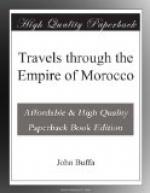On the outside of one of the western gates of Upper Fez are the gardens of the Emperor, surrounded by a good stone wall, within which are a number of spacious walks, shaded by rows of tall trees, on each side, and intersected by parterres and grass-plots, on which are elegant pavilions, some in a pyramidical, others in a conical form, where the Emperor frequently retires, to take his repose, or to amuse himself with his courtiers. These pavilions are between thirty and forty feet in height, covered on the outside with varnished tiles of different colours, and contain three and sometimes four neat apartments, furnished in the most simple style imaginable, having in general nothing more than a carpet, several couches, a few arm-chairs, a table, a clock, and a tea-equipage of china. The cornices round the walls of these apartments are embellished with passages from the Koran, and other Arabic sentences, carved in cedar-wood.
The propensity to cheating, so prevalent in all Barbary, is no where so notorious as in the lower town of Fez; and the Europeans who trade with the Moorish merchants here must employ the same means as themselves, or submit to be most flagitiously imposed upon.
I have visited several manufactories of carpets, mats, silk, linen, and leather, of which the merchants export great quantities. I have also seen some beautifully embroidered shawls, scarfs, and sword-knots, of the manufacture of this country. Their exports besides are, elephants’ teeth, ostrich feathers, copper, tin, wool, hides, honey, wax, dates, raisins, olives, almonds, gum-arabic, and sandrach. They carry on a considerable trade, by caravans, to Mecca and Medina, the inland regions of Africa, and to the farthermost parts of the coast of Guinea; from which last place they bring gold-dust, and a prodigious number of negroes, some of whom are destined to serve in the Emperor’s armies; the rest are slaves in the Moorish houses and fields.
The dress of the Moors is composed of a linen shirt, over which they fasten a cloth or silk vestment with a sash, loose trowsers reaching to the knee, a white serge cloak, or capote, and yellow slippers: their arms and legs are quite bare. The principal people are distinguished by the fineness of their turbans, their linen shirts, and cloth or silk garments, which are richly embroidered with gold; when they go abroad, they cover this dress with an alhaik, differing in quality according to the circumstances of the wearer; and which they fold round them like a large blanket. They never move their turbans, but pull off their slippers, when they attend religious duties, or their Sovereign, or visit their relatives, friends, priests, or civil and military officers.
The Moorish gentry are clean in their persons, in their manners tolerably genteel and complaisant, far from being loquacious, though not prone to reflection. They possess an unbounded degree of duplicity and flattery; are perfectly strangers to the notions of truth and honour, promising a thing one day which they utterly deny the next. They are less irascible than many other nations; but when grossly injured, seek revenge in assassination. They are more vindictive than brave, more superstitious than devout, firmly attached to their ancient customs, and wholly averse to every kind of innovation.




